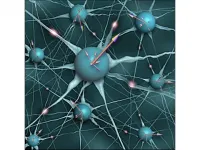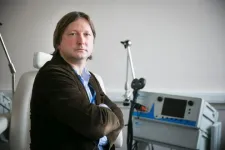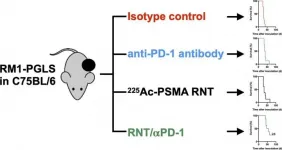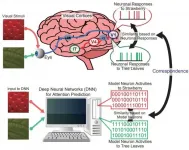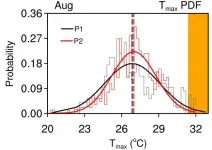(Press-News.org) An important class of challenging computational problems, with applications in graph theory, neural networks, artificial intelligence and error-correcting codes can be solved by multiplying light signals, according to researchers from the University of Cambridge and Skolkovo Institute of Science and Technology in Russia.
In a paper published in the journal Physical Review Letters, they propose a new type of computation that could revolutionise analogue computing by dramatically reducing the number of light signals needed while simplifying the search for the best mathematical solutions, allowing for ultra-fast optical computers.
Optical or photonic computing uses photons produced by lasers or diodes for computation, as opposed to classical computers which use electrons. Since photons are essentially without mass and can travel faster than electrons, an optical computer would be superfast, energy-efficient and able to process information simultaneously through multiple temporal or spatial optical channels.
The computing element in an optical computer - an alternative to the ones and zeroes of a digital computer - is represented by the continuous phase of the light signal, and the computation is normally achieved by adding two light waves coming from two different sources and then projecting the result onto '0' or '1' states.
However, real life presents highly nonlinear problems, where multiple unknowns simultaneously change the values of other unknowns while interacting multiplicatively. In this case, the traditional approach to optical computing that combines light waves in a linear manner fails.
Now, Professor Natalia Berloff from Cambridge's Department of Applied Mathematics and Theoretical Physics and PhD student Nikita Stroev from Skolkovo Institute of Science and Technology have found that optical systems can combine light by multiplying the wave functions describing the light waves instead of adding them and may represent a different type of connections between the light waves.
They illustrated this phenomenon with quasi-particles called polaritons - which are half-light and half-matter - while extending the idea to a larger class of optical systems such as light pulses in a fibre. Tiny pulses or blobs of coherent, superfast-moving polaritons can be created in space and overlap with one another in a nonlinear way, due to the matter component of polaritons.
"We found the key ingredient is how you couple the pulses with each other," said Stroev. "If you get the coupling and light intensity right, the light multiplies, affecting the phases of the individual pulses, giving away the answer to the problem. This makes it possible to use light to solve nonlinear problems."
The multiplication of the wave functions to determine the phase of the light signal in each element of these optical systems comes from the nonlinearity that occurs naturally or is externally introduced into the system.
"What came as a surprise is that there is no need to project the continuous light phases onto '0' and '1' states necessary for solving problems in binary variables," said Stroev. "Instead, the system tends to bring about these states at the end of its search for the minimum energy configuration. This is the property that comes from multiplying the light signals. On the contrary, previous optical machines require resonant excitation that fixes the phases to binary values externally."
The authors have also suggested and implemented a way to guide the system trajectories towards the solution by temporarily changing the coupling strengths of the signals.
"We should start identifying different classes of problems that can be solved directly by a dedicated physical processor," said Berloff. "Higher-order binary optimisation problems are one such class, and optical systems can be made very efficient in solving them."
There are still many challenges to be met before optical computing can demonstrate its superiority in solving hard problems in comparison with modern electronic computers: noise reduction, error correction, improved scalability, guiding the system to the true best solution are among them.
"Changing our framework to directly address different types of problems may bring optical computing machines closer to solving real-world problems that cannot be solved by classical computers," said Berloff.
INFORMATION:
A way of using machine learning to more accurately identify patients with a mix of psychotic and depressive symptoms has been developed by researchers at the University of Birmingham.
Patients with depression or psychosis rarely experience symptoms of purely one or the other illness. Historically, this has meant that mental health clinicians give a diagnosis of a 'primary' illness, but with secondary symptoms. Making an accurate diagnosis is a big challenge for clinicians and diagnoses often do not accurately reflect the complexity of individual experience or indeed neurobiology.
Clinicians diagnosing psychosis, for example, would frequently regard depression as a secondary illness, with implications for treatment decisions which focus more on ...
The outbreak of COVID-19 raised a question about the relationship between anthropogenic emissions and air pollution, which has aroused heated discussion. Research on air-quality changes caused by the lockdowns in different areas shows similar substantial reductions in primary emissions. However, regional disparities exist in responses of secondary pollutants to emissions reduction, especially fine particulate matter and ozone (O3).
Professor Ding Aijun and his team from Nanjing University explored global air-quality changes during COVID-19 lockdowns and regional disparities in O3 responses to emission reductions. They integrated multiple observational datasets, including global air quality ...
In a new study published in Journal of Extracellular Vesicles, Chen-Yu Zhang's group and Antonio Vidal-Puig's group at University of Cambridge report that pancreatic β cells secrete miR-29 family members (miR-29a, miR-29b and miR-29c) in response to high levels of free fatty acids (FFAs). These β cell-derived miR-29s are delivered to the liver, promoting insulin resistance and enhancing hepatic glucose output.
Over 100 years after insulin was discovered, it was believed that pancreatic β cells only secreted a single hormone--insulin. Pancreatic β cell-derived insulin regulates glucose homeostasis by binding with the insulin receptors located in the liver, skeletal ...
The scientists of Tomsk Polytechnic University jointly with the colleagues from Keysight company have conducted an experiment with an electron beam at the TPU microtron to study a super-radiant regime that occurs when radiation is generated by a train of electron bunches. The research findings obtained by a high-precision measurement of a spectral line width proved that about 8,000 electron bunches in a super-radiant regime form monochromatic Cherenkov radiation. This experiment was conducted for the first time. The fundamental research findings are published in the Scientific Reports academic journal (IF: 4.120, Q1) and can be used for further research on the new sources of radiation in the terahertz range.
A super-radiant regime is a coherent ...
Scientists at HSE University have learned that disagreeing with the opinion of other people leaves a 'trace' in brain activity, which allows the brain to later adjust its opinion in favour of the majority-held point of view. The article was published in Scientific Reports.
We often change our beliefs under the influence of others. This social behavior is called conformity and explains varios components of our behaviour, from voting at elections to fashion trends among teenagers.
Brain research has recently well informed about short-term effects of social influence on decision making. If our choice coincides with the point of view of the people who are important to us, this decision is reinforced in ...
Reston, VA--A combination of radionuclide therapy and immunotherapy has proven successful in slowing the progression of prostate cancer and increasing survival time, according to new research published in the February issue of The Journal of Nuclear Medicine. The results of the murine study indicate that radionuclide therapy promotes prostate cancer immunogenicity, provoking a cellular response that makes the tumors more receptive to immunotherapy.
"Prostate cancer is generally viewed as an immunological cold cancer in which immunotherapies only have moderate success," said Katharina Lückerath, PhD, assistant professor of preclinical ...
Geoscientists have released a video that for the first time shows the uninterrupted movement of the Earth's tectonic plates over the past billion years.
The international effort provides a scientific framework for understanding planetary habitability and for finding critical metal resources needed for a low-carbon future.
It reveals a planet in constant movement as land masses move around the Earth's surface, for instance showing that Antarctica was once at the equator.
The video is based on new research published in the March 2021 edition of ...
This discovery was made possible by applying the research method for the comparison of the brain activity between monkeys and humans to artificial neural networks. This finding might be helpful not only to understand the cortical mechanism of attentional selection but also to develop artificial intelligence.
Deep neural networks (DNNs), which are used in the development of artificial intelligence, are mathematical models for obtaining appropriate mechanisms to solve specific problems from the training with a large-scale dataset. However, the detailed mechanisms underlying DNNs through ...
On Feb 5th, Seoul National University, College of Engineering (Dean Kookheon Char) announced that Professor Sang Woo Seo's research team (Dr. Jina Yang and Mr. Yong Hee Han (graduate student)) at School of Chemical and Biological Engineering has developed a synthetic protein quality control system to enhance full-length translation in bacteria. This technology is expected to increase the efficiency of the production of biopharmaceuticals, industrial enzymes, and bio-based chemicals.
Recombinant proteins are used in various industrial fields from protein drugs such as insulin to industrial proteins such as laundry detergents. Since proteins can perform their functions only with full-length and proper 3D structure, recombinant protein production ...
Against the background of global warming, extreme heat days (EHDs) occur frequently and greatly threaten human health and societal development. Therefore, it is of great importance to understand the variation of EHDs.
Previous studies have indicated that the frequency of EHDs is mainly modulated by the mean state of temperature, and thus the frequency of EHDs mostly presents an increasing trend.
"However, the variability of the daily maximum temperature also plays an important role in the interdecadal change of extreme heat days over Northeast China," says Ms. Liu Wenjun, a Master's student from the group of Dr. Ruidan Chen in the School of Atmospheric Sciences ...
